Work Breakdown Structure (WBS) in Project Management
Careful planning is the key to improving the project success rate. But how do you plan gargantuan projects such as dam constructions or building entire skyscrapers?
Well, there’s a document that serves this exact purpose.
This document is called a work breakdown structure, or WBS for short, and it represents a hierarchical breakdown of a project into smaller fragments.
The WBS is so important that not having one — or having a poorly developed one — can lead to complete project failure. So, this guide will go over everything you need to know about the use of work breakdown structures in project management, how to craft one, and much more.
Let’s start!
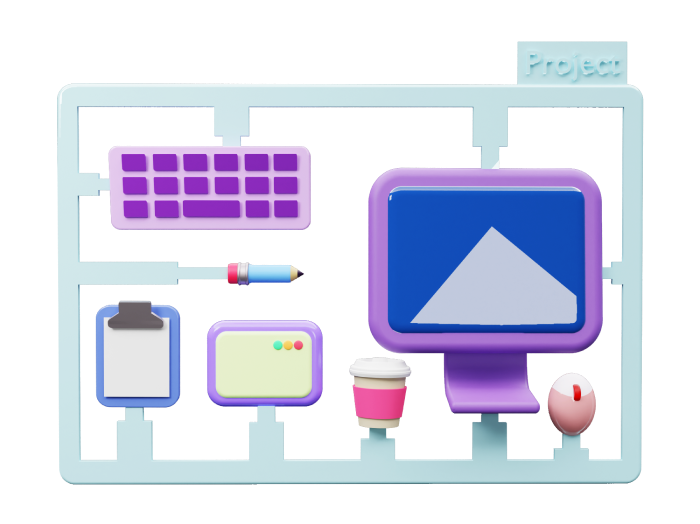
- The work breakdown structure hierarchically decomposes an entire project.
- The WBS is an element of the scope baseline, and thus, a part of the project management plan.
- Each WBS usually has 4 levels: the project objective, tasks, subtasks, and work packages.
- The structure should include 100% of the work needed to complete the project.
- You can make a WBS in project management software for easier use throughout your project.
Table of Contents
What is a work breakdown structure (WBS)?
A work breakdown structure is a project management tool used to fragment the project into manageable chunks and display them in the form of a hierarchical structure.
A WBS is created during the planning phase of the project lifecycle, and, according to APM, serves as a hierarchical structure of project activity.
The WBS usually comes in the form of a tree diagram. However, while not as common, it can also be a table, outline, or any other structure that clearly shows the hierarchy of WBS elements.
Here’s how that might look in project management software such as Plaky:
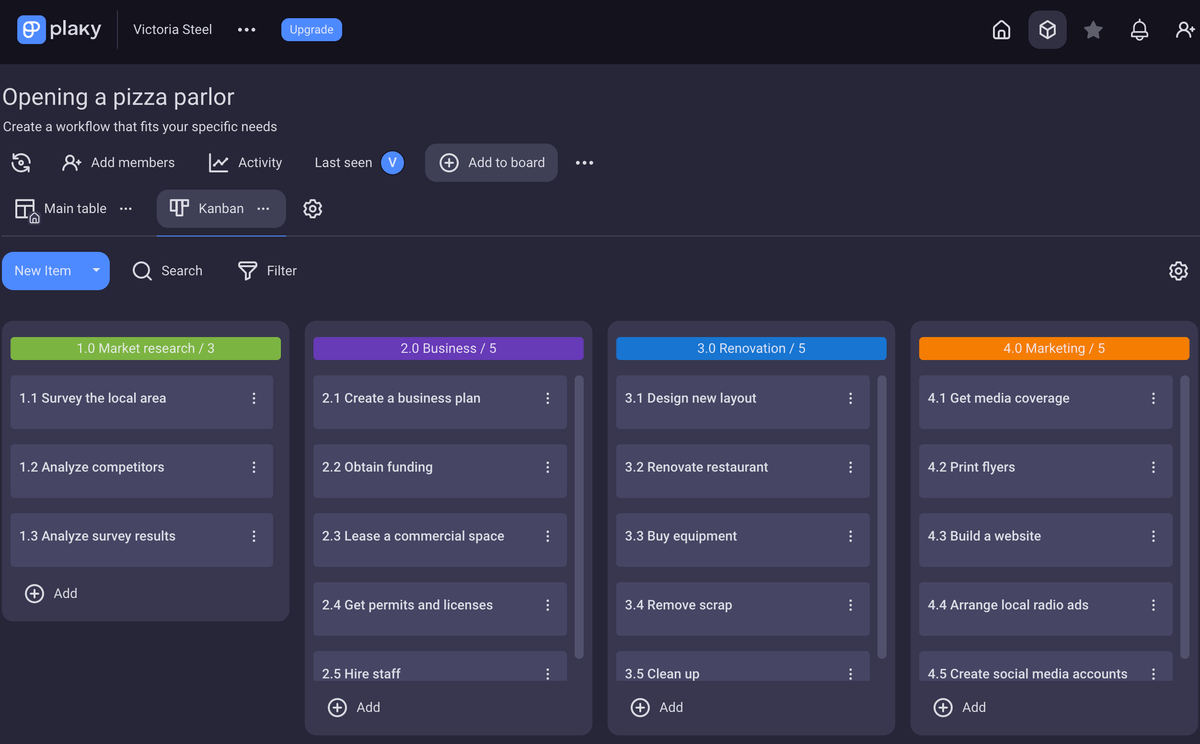
What is a WBS dictionary?
The WBS doesn’t contain additional information about the deliverables or tasks listed in it. Therefore, it’s necessary to create a separate document with all the details — the WBS dictionary.
The WBS dictionary is written by the project manager and contains all the minute information about every single item in the WBS. This includes:
- Estimated duration,
- Estimated cost,
- Due date,
- Acceptance criteria,
- Dependencies,
- Approvers, etc.
Due to its acute attention to detail, the WBS dictionary is a hefty document that can be hundreds of pages long.
Thus, organizations may choose to stop their WBS at level 4 (work packages) and exclude smaller activities.
This way, they avoid wasting time on writing exhaustive WBS dictionary entries for comparably insignificant project tasks.
What is the difference between a WBS and a project plan?
Along with the scope statement and the WBS dictionary, it’s an element of the scope baseline, which is itself part of the project management plan.
The key difference between a WBS and a project plan is that a WBS divides the project into multiple, controllable elements. Meanwhile, the project plan enacts a framework for project planning, execution, monitoring, and controlling.
What are the levels of a work breakdown structure?
To hierarchically decompose (as is the official term) a project into its smaller project deliverables, we must first understand the elements of that hierarchy — i.e., the WBS levels.
Here’s how Elizabeth Harrin, APM Fellow, the expert behind Rebel’s Guide to Project Management, and author of Managing Multiple Projects, explains WBS levels and related project decomposition:

“A WBS starts at the top level with an overall goal for the project. You then create other levels that help you decompose the work to do into manageable chunks, starting with major deliverables and splitting them up into smaller deliverables.”
The naming conventions of the WBS levels sometimes differ from organization to organization.
So, for the purposes of this article, we’ll rely on the hierarchy provided by the expert we talked to, Dr. Michael J. Shick, PMP, CSM, Owner/Founder of ROSEMET LLC, and Assistant Professor of Project Management at Western Carolina University.
According to him, the WBS hierarchy usually comprises these 5 levels:
- Project,
- Tasks,
- Subtasks,
- Work packages, and
- Activities.
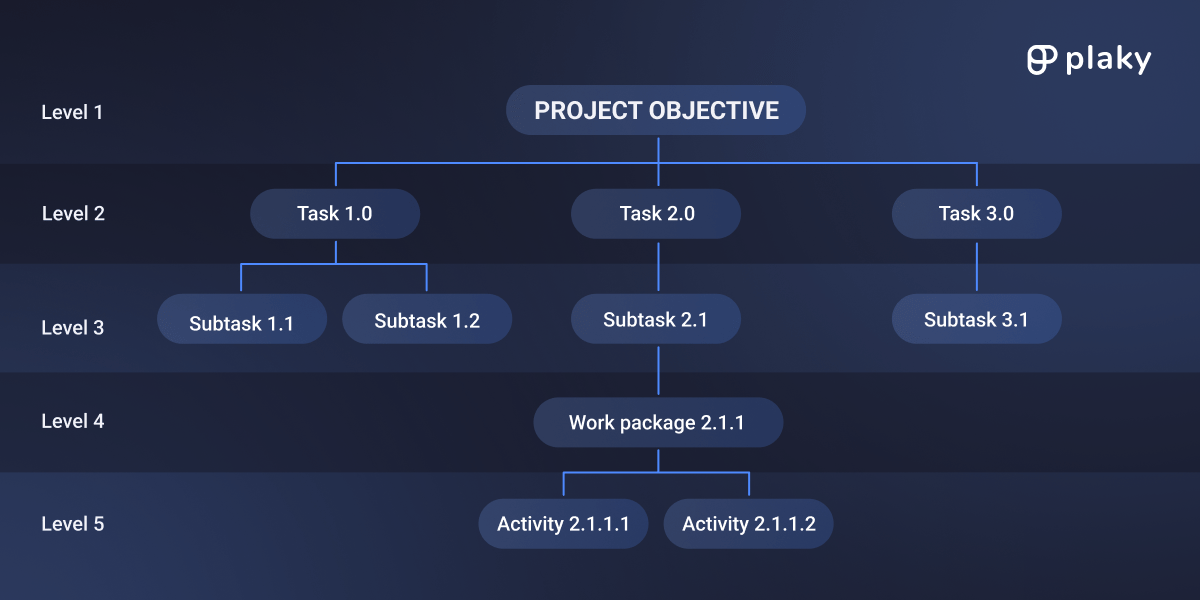
Let’s see what each WBS element is about, in more detail.
WBS level 1: Project
The first level in your WBS indicates the project itself or rather, the project objective that the project manager and the project team want to create. Therefore, it stands alone at the top of the WBS hierarchy.
To illustrate this, we’ll use a simple example:
Project objective = Opening a hair salon
To make this large chunk of work more manageable and organized, we divide it into smaller segments known as tasks.
WBS level 2: Tasks
Level 2 of a work breakdown structure contains the main tasks. Most often, these are the main deliverables of the project. However, they can also be project phases, depending on the industry and project type.
For our hair salon, we’ll have a few major tasks to focus one:
Task 1.0 = Business plan
Task 2.0 = Location
Task 3.0 = Equipment
Task 4.0 = Human resources
Task 5.0 = Marketing
There is no set number of elements that level 2, or any other level, should have. The WBS should contain as many elements as necessary to divide the project objective into its smallest constituents.
After determining the major deliverables or phases of the project, it’s time to divide each of them into their smaller constituent components — subtasks.
WBS level 3: Subtasks
Subtasks are level 3 elements of a work breakdown structure that represent mid-sized tasks or deliverables. Subtasks indicate all that has to be done to complete the main tasks, and eventually, the project objective.
In our example, the subtasks for task 4.0 (human resources) would be:
Subtask 4.1 = Staff recruitment
Subtask 4.2 = Staff training
Though they offer a more granular overview of the work needed to complete the main tasks, subtasks can still be further divided into the smallest WBS units — work packages.
WBS level 4: Work packages
Work packages are also known as terminal elements, and they are the smallest units or deliverables in a WBS. In general, work packages are sequences or groups of activities whose completion leads to a deliverable outlined in the previous level.
In our example, the work packages for subtask 4.1 (staff recruitment) would be:
Work package 4.1.1 = Decide on the job requirements
Work package 4.1.2 = Advertise the job positions
Work package 4.1.3 = Interview prospective candidates
Most project managers stop decomposing their projects at this level, as work packages are the smallest manageable work items that can be assigned to an individual or team.
As Dr. Michael J. Shick puts it:

“Level 4 work packages are those items that can be completed and “delivered.” This is the level where a project manager assigns individuals and resources. Further, work packages have start and end dates.”
That said, he also indicates that, depending on the project, your WBS can have the optional level 5 too.
WBS level 5: Activities
According to Dr. Michael J. Shick , “level 5 is the actual activities to be performed by the project team members who are assigned.”
According to him, activities are an optional or project-dependent part of a work breakdown structure. Whether you include them or not will likely depend either on the project or on the decisions made by the higher management.
In our example, the smallest activities we’d have to complete for the work package 4.1.3 (interview prospective candidates) would be:
Activity 4.1.3.1 = Schedule phone interviews
Activity 4.1.3.2 = Schedule skill demonstrations at the salon
Activity 4.1.3.3 = Make an offer to the selected candidates
According to Elizabeth Harrin, the number of levels your WBS ends up with depends on how much structure you need:

“I stop when the activity on the WBS feels like it would take about a week, or it falls within the responsibility of a single person to do. You don’t want to create so many levels that your tasks are broken down into tiny pieces that take hardly any time because that is difficult to manage going forward. Ultimately, you need as many levels as it helps you structure the work and control the project.”
Types of work breakdown structures
There are 2 types of work breakdown structures in project management:
- Deliverable-oriented, and
- Phase-oriented.
Both types can look the same visually, but they present information in different ways. The main difference is the way they divide the work at level 2 of the WBS.
Let’s take a closer look at them.
Type #1: Deliverable-oriented WBS
Deliverable-oriented work breakdown structures list all the smaller products of work that, put together, comprise the final product.
In other words, it names the level 2 items by their expected tangible outcomes (deliverables) instead of the actions needed to achieve them.
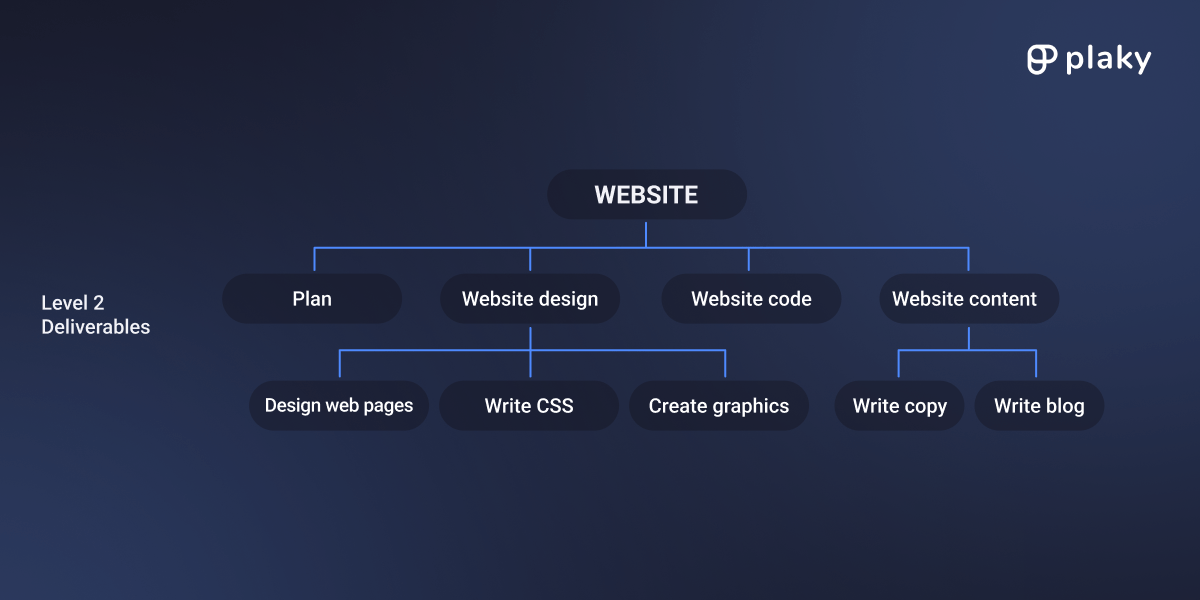
Note that, in the example above, the level 2 items carry the names of the 4 main deliverables needed to complete a website (plan, website design, website code, and website content). These are then divided into their smaller constituents.
Type #2: Phase-oriented WBS
Phase-oriented work breakdown structures list the phases of the project’s lifecycle and the activities that comprise those phases instead of the outcomes of those activities. Thus, it makes more sense to use them for projects that involve sequential stage-like phases, such as product development.

In the example above, level 2 highlights the main project phases (initiation, design, code, test, and closing phase) as opposed to deliverables.
Keep in mind there are no specific rules about using one type of WBS or the other. This entirely depends on the type of project, the organization, and the preferences of the project manager.
That said, you may want to decide in advance how you’ll write the rest of your WBS elements.
As stated in the Practice Standard for Work Breakdown Structures – 2nd Edition, “verbs are not used to identify WBS elements”. So, you may come across a WBS that is entirely noun-oriented, i.e., it lists specific components at each level.
Nevertheless, practice has shown it’s acceptable to write the WBS elements as instructions, e.g., “write code”, since they describe work.
The expert we talked to, Elizabeth Harrin, echoes this sentiment:

“A WBS describes the work, so it’s tasks, and I would use verbs. I think as long as it’s useful for the next stage, which is sequencing the activities to create the schedule, then however you want to do it is OK, but personally for me, I’d stick with verbs because it’s about the work to be performed.”
How to create a work breakdown structure
According to Dr. Michael J. Shick , the basic framework for making a WBS is as follows:
- Define the project scope,
- Identify the deliverables,
- Break down the deliverables,
- Assign identification numbers,
- Define the work packages and apply resources,
- Review and refine the WBS, and
- Document the WBS.
Let’s go through each of the steps in more detail.
Step #1: Define the project scope
In regard to the creation of the WBS, Dr. Michael J. Shick highlights the importance of involving the whole team:

“The project team, functional leads, and project manager should be involved with developing the WBS. This ensures the benefits of the diversity of thought are maximized, and all work is identified.”
So, to determine the key project objectives, you must first define the scope of the project and thoroughly understand:
- The project’s intended direction,
- Project goals, and
- Project stakeholders and their responsibilities.
As Dr. Michael further explains, defining the project scope “shall be done in conjunction with the customer/client, project team, and may include other stakeholders.”
All of this, including the main project deliverables, should be documented in the project charter.
Step #2: Identify the deliverables
Once you understand the scope, you can move onto identifying the project’s main deliverables.
According to Dr. Michael J. Shick , this step requires you to “create a list of all the major outcomes (i.e., product/service to be delivered) agreed upon with the customer/client.”
As soon as you and your project team are clear on the main deliverables, you can start decomposing them into smaller units.
Step #3: Decompose the deliverables
Once you have the main deliverables, begin breaking them down into smaller, more manageable, independent sections.
Take care not to duplicate entries in this step. Remember to also consult the subject matter experts in your team to ensure the WBS covers 100% of the project work and there are no overlaps.
Step #4: Assign identification numbers
This step involves using a coherent coding scheme to number the elements. A decimal sequence is often used to number the WBS elements.
Step #5: Define the work packages and apply resources
Step #5 requires you to distribute the work you have so meticulously broken down into bite-sized management units.
According to Dr. Michael J. Shick, in this step, you “identify the actual work to be performed and assign personnel, schedule (i.e., dates), cost estimate, performance measurements, etc.”
Step #6: Review and refine your WBS
Once the WBS is done, you should review it to identify any gaps that might have slipped under your radar. But that’s not the end of the process — your WBS should be refined throughout the project too.
According to Eric Risner, PMI-ACP and founder of Rise Up Leadership LLC, it’s not in the nature of a WBS to be fixed:
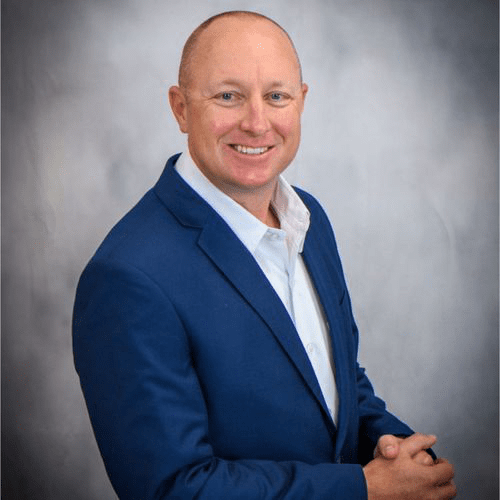
“The business landscape is rapidly changing, [and] so are individual projects. Stakeholders may update their expectations, budgets can be raised or lowered throughout the project lifespan, and other outside factors can impact a project’s timeline and priority. Because of this, I always recommend that project managers not treat their work breakdown structure as immovable. PMI research shows that project managers must be increasingly agile, even if they are using a Waterfall or predictive way of working.”
Step #7: Document the WBS
As mentioned before, you should also write an exhaustive document (the WBS dictionary) that thoroughly explains each item listed in the WBS. This document should, apart from explaining the work, contain information about:
- Required project resources,
- Milestones,
- Assigned team members, etc.
In this step, Dr. Michael J. Shick highlights assumptions and constraints in particular, saying that “any key assumptions and constraints related to the WBS should be identified and articulated.”
💡 Plaky Pro Tip
If you’re a fan of Excel, you’ll love the fact that you can also create your WBS in it — we’ve prepared some templates to help you in the process. Find them below:
Work breakdown structure in project management example
Now that we’ve explained the elements, steps, and rules of creating a work breakdown structure, let’s take a look at a simple, 3-level example that brings them together.
For the sake of simplicity, we’ll turn a team building event into a phase-oriented project. But the principle is the same for any type of project.
Let’s say that the project involves planning and executing an annual team building event:
| Level 1 | Annual team building event | |||
|---|---|---|---|---|
| Level 2 | 1.0 Initiation | 2.0 Preparation | 3.0 Execution | 4.0 Closing |
| Level 3 | 1.1 Create a timeline 1.2 Make a guest list 1.3 Set the budget 1.4 Coordinate the planning team | 2.1 Create the program 2.2 Book the venue 2.3 Arrange the transportation 2.4 Hire a caterer 2.5 Book the entertainment | 3.1 Welcome guests 3.2 Enjoy the event 3.3 Say goodbye | 4.1 Send follow-up surveys 4.2 Discuss future improvements |
In this example, the WBS has 3 levels:
- Level 1 — the final project objective, which is a company’s annual team building event,
- Level 2 — 4 phases, and
- Level 3 — subtasks presented in each of the 4 columns and numbered accordingly.
Here’s how the project can be displayed in a project management tool like Plaky:
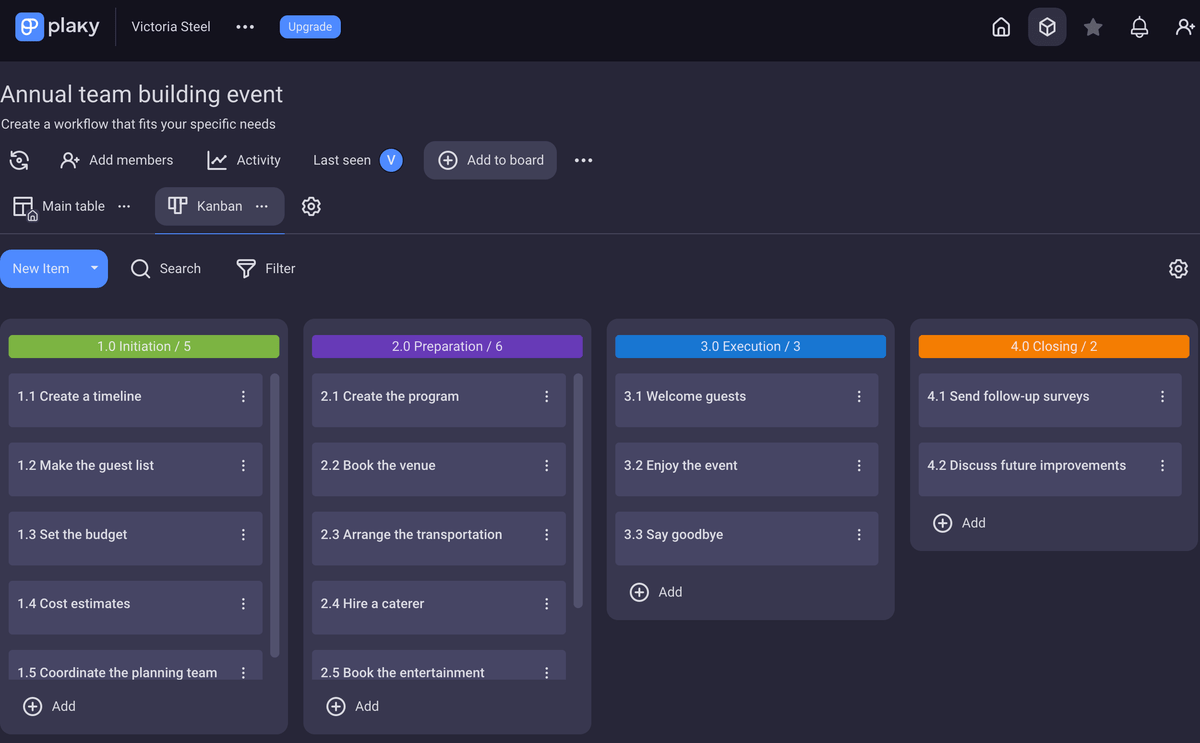
As you can see, the WBS gives you an idea of how the event should be prepared and executed. However, for more details, you have to refer to the WBS dictionary.
This team building event plan is a simple example of a 3-tier WBS. After finalizing each of the work packages within a phase, you complete a phase. Completing all 4 phases marks the end of the project.
💡 Plaky Pro Tip
WBS is one of the most used project management techniques out there. Check out some other popular project management tools here:
7 Tips for writing a work breakdown structure
The way a WBS is created greatly depends on the project manager and the organization they work for. Still, there are a few rules and guidelines to follow when writing a WBS.
These include:
- Including 100% of the work in the WBS,
- Ensuring same-level items are independent of each other,
- Avoiding duplicating the WBS elements,
- Adhering to the 8/80 rule,
- Using a coherent coding scheme,
- Keeping it detailed but easy to understand, and
- Not overthinking it.
Let’s go through these guidelines in more detail.
Tip #1: Include 100% of the work in the WBS
Although written in proverbial bullet points, the WBS should include 100% of the work needed to complete the project — no more, and no less. This doesn’t mean the WBS should include every inconsequential detail. But, once you determine to which level you will decompose your project, take care to omit nothing.
Tip #2: Ensure same-level items are independent of each other
One of the reasons a WBS has different levels is to make it clear the items on the higher levels are dependent on the items directly below them. However, when it comes to the items that are on the same level, they should be entirely independent of one another.
If, for example, you find that the completion of one level 3 item of a WBS depends on the completion of another level 3 item, it’s a sign something is wrong. In that case, you should redo your WBS.
Tip #3: Do not repeat the WBS elements
One hard and fast rule of creating a WBS is that no item in your WBS should be duplicated.
All WBS elements should be mutually exclusive and therefore unique, as duplicating them can create dependencies between items on the same level.
By creating those dependencies, the duration and cost estimates for the entire project may be off, not to mention that you would break the 100% rule mentioned above and cause work overlap.
Tip #4: Stick to the 8/80 rule
If you’re not sure whether you’ve bitten more than you can chew with each work package, stick to the 8/80 rule.
The 8/80 rule, albeit more of a guideline, is useful for determining the ideal size of your work packages. This “rule”, also known as the 10-day rule, states that the work packages should require no less than 8 hours and no more than 80 hours, or 10 days, to complete.
Tip #5: Use a coherent coding scheme
Otherwise known as the code of accounts, the coding scheme is a necessary part of any WBS. Think of it as a numbering system for headings and subheadings.
While it’s not particularly significant for the WBS itself, it’s critical when trying to make sense of the WBS dictionary. With a coherent coding scheme, each WBS element gets a unique identifier, which enables easier control and monitoring of the project and its scope.
Tip #6: Make it detailed but easy to understand
It’s vital to make your WBS detailed to ensure successful project completion. However, overdoing it by adding too many levels can certainly make it beyond complicated to understand and follow.
As explained by Dr. Michael J. Shick, the WBS must be easy to comprehend:

“The WBS is the foundation of effective project management, and because of that, a project manager should ensure they are detail-oriented by identifying the necessary details appropriate for the level while not overwhelming. The naming convention should be clear and concise, deliverable-oriented, and distinct, and it should not use technical language so it is easily understood by stakeholders. There should not be any confusion or overlap in the work that must be completed.”
A complex structure can also make it harder to add changes properly — which may lead to potential delays and overall confusion among the project team.
Besides, your WBS should give information about what you plan to accomplish throughout the project, but in simple terms. So, there’s no need to make its building blocks too elaborate — focus on the outcomes, not the methods.
Tip #7: Don’t overthink it
As mentioned, your WBS has to be regularly updated throughout the project. Because of that, it’s imperative not to overthink it in advance but instead let it adapt naturally to the project changes.
As one of the experts we talked to, Eric Risner, puts it:

“You must allow your work breakdown structure to evolve with your project to adapt to the challenges and expectations. Focusing on each detail upfront will lead to analysis paralysis.”
According to Eric, analysis paralysis “is when an individual or a group becomes so immersed in analyzing a situation or problem that they cannot decide or take action.”
Why use a work breakdown structure?
A poorly constructed or non-existent WBS is often the cause of complete project failures, according to Brotherton, Fried, and Norman’s paper “Applying the Work Breakdown Structure to the Project Management Lifecycle.”
The WBS offers so many benefits that, even if there are other approaches they like better, project managers still choose it over any other.
Some of the benefits of using WBS are that it:
- Eliminates uncertainty,
- Makes it easier to develop a project schedule,
- Sets clear benchmarks and milestones,
- Helps identify dependencies,
- Helps identify project risks,
- Improves team organization and productivity, and
- Improves timeline and budget estimates.
Benefit #1: A WBS eliminates uncertainty
One of the biggest advantages of using a WBS to break down your project is that it tells you exactly where you should direct your efforts.
According to Elizabeth Harrin, one of the reasons why the WBS is important in project management is that it eliminates uncertainty:

“I think it’s really important to break down the work so you know exactly what is required. Without that clear picture, it’s hard to move on to the next step of project planning and create a schedule with assigned resources.”
Benefit #2: A WBS makes it easier to develop a project schedule
Since a WBS gives you a clearer idea of what you must do throughout the project, it also makes it easier to create a project schedule. Since the WBS already contains 100% of the work that needs to be completed, and that work is already prioritized and divided into smaller chunks, half the work for completing a project schedule is already done.
Benefit #3: A WBS helps set clear benchmarks and milestones
With a visual representation of the work decomposition, it should be easier to set milestones and know exactly what’s necessary to complete them. A well-crafted WBS also helps in benchmarking progress against expectations.
Benefit #4: A WBS helps identify dependencies
Having a breakdown of all the deliverables or activities “on paper” helps identify specific project dependencies among certain WBS elements that might influence the project.
As you move on to the next stage of project planning, you can represent these dependencies in other visual tools, like the Gantt chart.
Unlike the WBS, which shows project activities hierarchically and focuses on their outcomes, the Gantt chart shows them linearly and focuses on the project timeline and task relationships.
Benefit #5: A WBS helps identify project risks
According to Devi and Reddy’s paper on the importance of WBS in project management, having a well-defined work breakdown structure helps project managers track the work from the smallest deliverables to the level of the entire project.
This could aid project risk management, as it makes it easier to detect those small tasks that can sometimes have long-reaching consequences.
Benefit #6: A WBS improves team organization and productivity
A visual representation of work helps fit all the pieces of the project together, allowing teams to understand their exact role in the overall scheme of things and the reason for performing their respective tasks.
One of the experts we talked to, Eric Risner, emphasizes how the tool brings order to project management:

“[A WBS] makes a natural order for a process, which can be very helpful, especially for projects using Waterfall or predictive methodologies. It is a tool that allows project managers and their teams to stay on top of their tasks, making it an essential part of a project.”
Essentially, the WBS helps team members understand exactly what lies ahead, when, and why, and motivates each individual to perform their tasks more effectively, improving productivity in the process.
Benefit #7: A WBS improves timeline and budget estimates
A detailed decomposition of work significantly decreases the margin of error when estimating the budget and task duration.
While working on a larger scale might cause some of the costs and time losses to be overlooked, multiple smaller-scale estimates paint a much more accurate picture of the actual project constraints.
💡 Plaky Pro Tip
To help keep your cost estimates in check, you may want to consider using a cost forecasting method called estimate at completion (EAC). Read more about it here:
Drawbacks of using a work breakdown structure
As for the disadvantages of using a work breakdown structure in project management, there aren’t that many.
Undoubtedly, one of the biggest drawbacks is that a WBS is time-consuming to write and update.
Depending on how complex the project is, writing the WBS may take a lot of time, especially since it’s important to get everyone’s buy-in to not miss out on any of the details. Plus, it might take even more time if you’re inexperienced or don’t have the whole scope.
And once you do write it, be ready to spend precious time on updating it as the project changes to ensure successful completion. The WBS is a living document, so to speak, so you should modify it whenever necessary.
That said, not every project may warrant a full WBS. As Elizabeth Harrin says:

“A full WBS involves a lot of documentation, for example, the WBS dictionary. Sometimes, smaller projects don’t warrant that level of rigor, and you can get away with doing a simpler, more straightforward exercise where you do break down the work, but you create a basic list instead of a complete WBS.”
Helpful tools for creating a WBS
Project managers know good project management software makes all the difference when managing a project. This is why 44% of senior executives list digitalization as a major investment priority, recognizing the necessity of digital tools for the future of the trade.
Project management tools such as Plaky are modern, easy to use, and have all the functionality needed to bring your project management game to the next level.
With Plaky, you can:
- Centralize project data to ensure all information is readily available at all times,
- Effectively correspond with teammates and manage your team’s work in real time, and
- Create and store important task lists, documents, and files in one place.
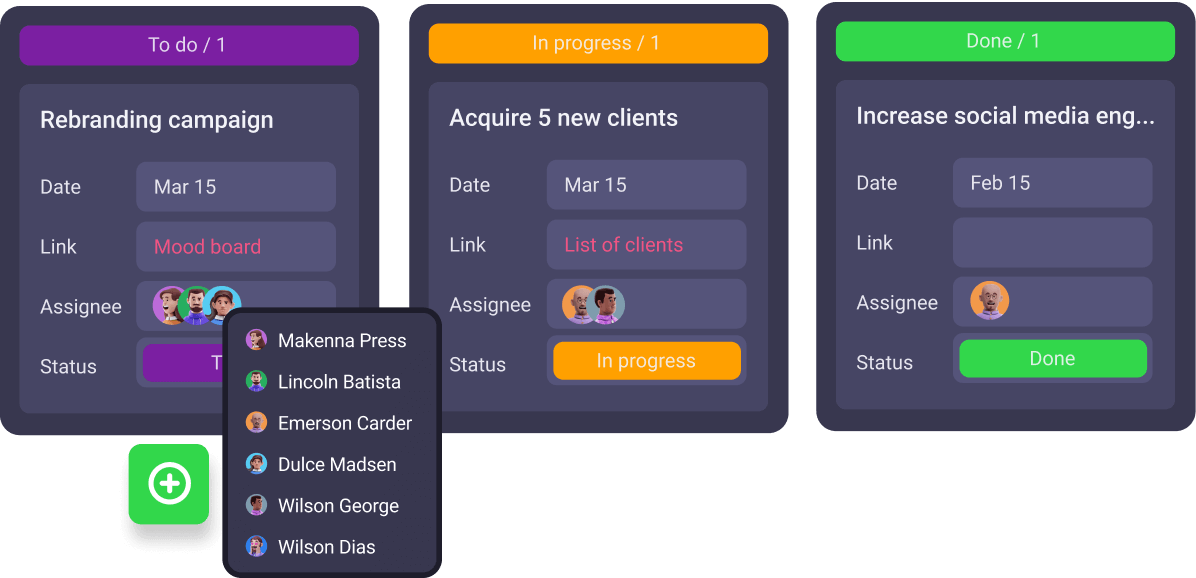
With this, all the information necessary for creating an immaculate work breakdown structure will be at your fingertips.
Dr. Michael J. Shick confirms this and adds that certain software can also help with updating the WBS:

“Remember that the WBS is dynamic and will require updates; therefore, it is helpful to leverage software or tools that will assist in creating, providing a visual representation, and managing the WBS.”
📖 The work breakdown structure is just one of the elements of project management you should know about. If you’re interested in learning more about managing projects, check out our Project Management Glossary of Terms to further explore basic and advanced PM terminology.
Elevate your project management with Plaky
Planning is an integral part of any project, but sticking to the plan and adapting it as the project advances is a different challenge entirely. Fortunately, project management apps like Plaky make it easier to manage tasks, collaborate, and review progress.
References
- Brotherton, A, S., Fried, T, R., and Norman, S, E. (2008). Applying the Work Breakdown Structure to the Project Management Lifecycle. Retrieved October 13, 2023 from http://citeseerx.ist.psu.edu/viewdoc/download;jsessionid=94FADBCEAF381B24F816E8475201E83A?doi=10.1.1.169.1963&rep=rep1&type=pdf
- Devi, R, T., and Reddy, S, V. (2012). Work Breakdown Structure of the Project, Retrieved October 13, 2023 from https://citeseerx.ist.psu.edu/viewdoc/download?doi=10.1.1.416.8659&rep=rep1&type=pdf
- Project Management Institute. (2020). Ahead of the Curve: Forging a Future-Focused Culture. Retrieved October 13, 2023 from https://www.pmi.org/-/media/pmi/documents/public/pdf/learning/thought-leadership/pulse/pmi-pulse-2020-final.pdf?v=2a5fedd3-671a-44e1-9582-c31001b37b61&sc_lang_temp=en
- Use of Product Breakdown Structures and Work Breakdown Structures. APM. (n.d.). Retrieved October 13, 2023 from https://www.apm.org.uk/resources/find-a-resource/use-of-product-breakdown-structures-and-work-breakdown-structures/
- Practice Standard for Work Breakdown Structures. Project Management Institute. https://www.goodreads.com/en/book/show/1427228
 Project Management Hub
Project Management Hub 











